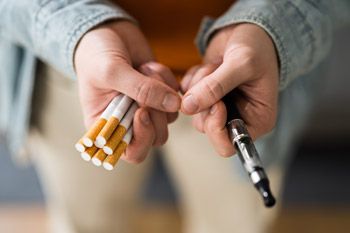Smoking and Vaping's Impact on North Dakota Youth
by Sarah DiDonna
December 2023
Most people know that cigarette smoking poses many health risks that have been backed by decades of research. But what about vaping? Isn't vaping safer than smoking a cigarette? Vapes were created as a healthier alternative to cigarettes, but new studies have found that chemicals in vapors now pose many new health risks that youth may be unaware.
 The three forms of smoking all have health risks but
vapes and e-cigarettes cause harm differently than
traditional cigarettes. It's important to know how vapes
work to understand how this causes harm. This electronic
device contains nicotine, flavoring, and other chemicals
in a liquid “pod” or
“cartridge.” The device heats the
liquid and vapors are inhaled into the lungs. The inhaled
microparticles can cause side effects like mouth dryness,
throat irritation, cough, and headaches.
The three forms of smoking all have health risks but
vapes and e-cigarettes cause harm differently than
traditional cigarettes. It's important to know how vapes
work to understand how this causes harm. This electronic
device contains nicotine, flavoring, and other chemicals
in a liquid “pod” or
“cartridge.” The device heats the
liquid and vapors are inhaled into the lungs. The inhaled
microparticles can cause side effects like mouth dryness,
throat irritation, cough, and headaches.
When cigarette smoke is inhaled into the lungs, its large particle size can only travel so far. However, the inhaled particles from vaping are smaller than those in cigarettes and are able to travel deeper into all the nooks and crannies of the lungs. There they are deposited extensively, block normal oxygen exchange, and potentially cause breathing problems. Some microparticles are even small enough to actually get into the bloodstream, where there is more risk for damage and disease.
The microparticles of vaping include a number of a small molecules, one of which is H2O2, or hydrogen peroxide. Although not harmful when used as an oral rinse, when it enters the bloodstream H2O2 damages cells which increases the risk of infections and disease, especially for people who already have asthma or diabetes.
Recent research has also found that vaping increases a receptor linked to insulin resistance, a term used to describe how diabetes develops from chronic high blood sugar. For younger vapers with hopes of keeping their youthful appearance, researchers have also linked vapor chemicals to faster rates in aging.
Understanding the research that vaping is not as safe as once thought might be important information for North Dakota's youth and their communities. Nearly 10% of the state's high schoolers vape daily and 1 in 3 students have tried a cigarette before age 13, according to recent state health department surveys.
With no data to support any positive health benefits of smoking, for those youth – or adults – who smoke or vape and want to quit, the NDQuits website has information on how to access personal assistance and counselors to quit. Adams County local health care providers and tobacco treatment specialists are available for those who are looking to breathe clearly and begin a journey towards a smoke free life.
This article also appeared in the December 28, 2023 issue of the Adams County Record and in the December 29, 2023 issue of the Bismarck Tribune.
About the Author
 Sarah DiDonna is a third-year medical student at
the University of North Dakota School of Medicine &
Health Sciences. She was selected as the Hettinger
participant for the school's ROME program, or Rural
Opportunities in Medical Education. The program focuses
on teaching student doctors the importance of rural
newspapers as a way to share health information. As a
future rural healthcare leader, DiDonna has written this
column to provide health information for her ROME
community. The information is not for diagnosis or
treatment and should not be used in place of previous
medical advice provided by a licensed provider.
Sarah DiDonna is a third-year medical student at
the University of North Dakota School of Medicine &
Health Sciences. She was selected as the Hettinger
participant for the school's ROME program, or Rural
Opportunities in Medical Education. The program focuses
on teaching student doctors the importance of rural
newspapers as a way to share health information. As a
future rural healthcare leader, DiDonna has written this
column to provide health information for her ROME
community. The information is not for diagnosis or
treatment and should not be used in place of previous
medical advice provided by a licensed provider.
